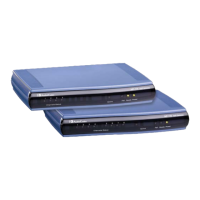Version 7.2 993 Mediant 1000B Gateway & E-SBC
User's Manual 62. Configuration Parameters Reference
Parameter Description
If VBD coder negotiation fails at call start and if the IsFaxUsed
parameter is set to 1 (or 3), then the channel opens with the
FaxTransportMode parameter set to 1 (relay) to allow future
detection of fax tones and sending of T.38 Re-INVITES. In such a
scenario, the FaxVBDBehavior parameter has no effect.
This feature can be used only if the remote party supports T.38 fax
relay; otherwise, the fax fails.
[NoAudioPayloadType] Defines the payload type of the outgoing SDP offer.
The valid value range is 96 to 127 (dynamic payload type). The default
is 0 (i.e. NoAudio is not supported). For example, if set to 120, the
following is added to the INVITE SDP:
a=rtpmap:120 NoAudio/8000\r\n
Note: For incoming SDP offers, NoAudio is always supported.
SIP Transport Type
configure voip > sip-
definition settings > app-sip-
transport-type
[SIPTransportType]
Determines the default transport layer for outgoing SIP calls initiated
by the device.
[0] UDP (default)
[1] TCP
[2] TLS (SIPS)
Note:
It's recommended to use TLS for communication with a SIP Proxy
and not for direct device-to-device communication.
For received calls (i.e., incoming), the device accepts all these
protocols.
Display Default SIP Port
configure voip > sip-
definition settings > display-
default-sip-port
[DisplayDefaultSIPPort]
Enables the device to add the default SIP port 5060 (UDP/TCP) or
5061 (TLS) to outgoing messages that are received without a port.
This condition also applies to manipulated messages where the
resulting message has no port number. The device adds the default
port number to the following SIP headers: Request-Uri, To, From, P-
Asserted-Identity, P-Preferred-Identity, and P-Called-Party-ID. If the
message is received with a port number other than the default, for
example, 5070, the port number is not changed.
An example of a SIP From header with the default port is shown
below:
From:
<sip:+4000@10.8.4.105:5060;user=phone>;tag=f25419a
96a;epid=009FAB8F3E
[0] Disable (default)
[1] Enable
Enable SIPS
configure voip > sip-
definition settings > enable-
sips
[EnableSIPS]
Enables secured SIP (SIPS URI) connections over multiple hops.
[0] Disable (default)
[1] Enable
When the SIPTransportType parameter is set to 2 (i.e., TLS) and the
parameter EnableSIPS is disabled, TLS is used for the next network
hop only. When the parameter SIPTransportType is set to 2 or 1 (i.e.,
TCP or TLS) and EnableSIPS is enabled, TLS is used through the
entire connection (over multiple hops).
Note: If the parameter is enabled and the parameter
SIPTransportType is set to 0 (i.e., UDP), the connection fails.

